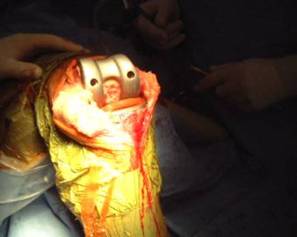Introduction
A joint is formed by the ends of two or more bones which are connected by thick tissues. For example, your knee joint is formed by the lower leg bone, called the tibia or shin bone, and your thighbone, called the femur. Your hip is a ball and socket joint, formed by the upper end of the femur, the ball, and a part of the pelvis called the acetabulum, the socket.
The bone ends of a joint are covered with a smooth layer called cartilage. Normal cartilage allows nearly frictionless and pain-free movement. However, when the cartilage is damaged or diseased by arthritis, joints become stiff and painful (e.g. osteoarthritis, rheumatoid arthritis, avascular necrosis or congenital joint deformity ). Every joint is enclosed by a fibrous tissue envelope or a capsule with a smooth tissue lining called the synovium. The synovium produces fluid that reduces friction and wear in a joint.
When only some of the joint is damaged, a surgeon may be able to repair or replace just the damaged parts. When the entire joint is damaged, a total joint replacement is done. To replace a total hip or knee joint, a surgeon removes the diseased or damaged parts and inserts artificial parts, called prostheses or implants.
Is it necessary to do total joint replacement?
The goal is to relieve the pain in the joint caused by the damage done to the cartilage. The pain may be so severe, that a person will avoid using the joint. This may then cause weakening of the muscles around the joint, making it even more difficult to move the joint. A physical examination, possibly some laboratory tests and x-rays will show the extent of damage to the joint. Total joint replacement will be considered if other treatment options will not relieve your pain and disability.
Hip, knee, shoulder and elbow joint are commonly replaced with artificial joint nowadays. There are other joints which are less commonly done due to inconsistent outcome of the surgery (ankle, wrist and finger).

Picture of an implant of total knee joint replacement
Recovery process
In general, your orthopaedist will encourage you to use your “new” joint shortly after your operation. After total hip or knee replacement you will often stand and begin walking the day after surgery. Initially, you will walk with a walker, crutches or a cane. Most patients have some temporary pain in the replaced joint because the surrounding muscles are weak from inactivity and the tissues are healing but it will end in a few weeks or months.
Exercise is an important part of the recovery process. Your orthopaedics surgeon or the staff will discuss an exercise program for you after surgery. This varies for different joint replacements and for differing needs of each patient.
After your surgery, you may be permitted to play golf, walk and dance. However, more strenuous sports, such as tennis or running, may be discouraged.
The motion of your joint will generally improve after surgery. The extent of improvement will depend on how stiff your joint was before the surgery.
Possible complications
- Infection: It can occur as early as after the surgery or years later. Minor infections in the wound area are generally treated with antibiotics. Major or deep infections may require more surgery and removal of the prosthesis.
- Blood Clots: Blood clots result from several factors, including decreased mobility causing sluggish movement of the blood through your leg veins. Blood clots may be suspected if pain and swelling develop in your calf or thigh. If this occurs, your orthopaedics surgeon may consider tests to evaluate the veins of your leg. There are several ways to prevent and treat this condition in which your surgeon will discuss with you.
- Loosening: Loosening of the prosthesis within the bone may occur after a total joint replacement. This may cause pain. If the loosening is significant, a revision of the joint replacement may be needed.
- Dislocation: Occasionally, after total hip replacement the ball can be dislodged from the socket. In most cases, the hip can be relocated without surgery. A brace may be worn for a period of time if a dislocation occurs. Most commonly, dislocations are more frequent after complex revision surgery.
- Wear : Some amount of wear can be found in all joint replacements. Excessive wear may contribute to loosening which may require revision surgery.
- Prosthetic breakage : Breakage of the metal or plastic joint replacement is rare but can occur. A revision surgery is necessary if this occurs.
Is total joint permanent?
Most older persons can expect their total joint replacement to last a decade or more. It will give years of pain-free living that would not have been possible otherwise. Younger joint replacement patients may need a second total joint replacement. The future is bright for those who choose to have a total joint replacement to achieve an improved quality of life through greater independence and healthier pain-free activity.
Reference
Campbell Operative Orhtopaedic
| Last reviewed | : | 25 April 2012 |
| Writer | : | Dr. Izan Ibrahim |
| Reviewer | : | Dr. Heselynn Hussein |







